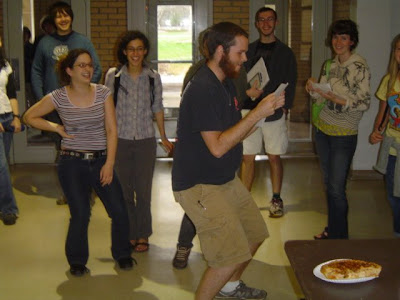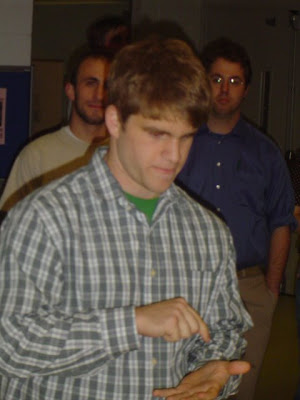I've now had two days to recover from the hedonistic revelry that accompanied this year's observance of that most hallowed of days, Pi Day, March 14th, and I've a few minutes of time in which to sit down and chronicle the occasion.
This is the second straight year we've put a bit of effort (more this year than last) into celebrating this immovable mathematical feast, and that effort paid off, with roughly fifty folks, mostly Math Department students and faculty and their close acquaintances, in attendance at the 1:59 ceremonies.
What went on?
For some weeks now Stanley (our Math Club president) and I have been mulling over various means of approximating π probabilistically that would lend themselves to audience participation. The classic Buffon's needle experiment (implemented here on George Reese's homepage at the University of Illinois, Urbana-Champaign) could be replicated by allowing passersby to chuck hot dogs into an enclosure with a ruled surface, enabling a running tally of hot dogs that strike a line. The cost of implementing this procedure would be rather high, unless we wanted to reuse the same hot dogs over and over and over(an icky proposition)...plus there's the need for constant supervision of the enclosure, and we've called upon our students quite a bit lately, what with the recent Math Literacy Summit. To bring the cost down, we thought then about replacing the hot dogs with pixie sticks, which would be more inexpensive and likely more accurate (there would be less error incurred by the thinner width of the pixie sticks), but we'd still have to ensure the event was continually monitored, in order to tally up the results of the experiment.
Then I hit upon the idea of just doing a simple Monte Carlo area estimate: build a small square enclosure, and let people chuck spare change into it throughout the day. At the day's end, collect all of the coins that lay within a circle centered at the enclosure's middle, and divide by the total number of coins present. This ratio should be roughly π/4, the ratio of the circle's area to that of the square. Assuming a fair degree of faith in human nature, there'd be no need to oversee the experiment, since the coins would only minimally interfere with one another. All we'd have to do is put the booth up in the morning and take it down at night after carefully cataloging the location of the coins.
This we did. I spent a few minutes on the evening of the 13th drilling holes in the plywood and posts, and then Maggie and I schlepped the assemblage up to campus, along with the roughly 18 pounds of pie we'd bought for the pie-eating to take place on the following afternoon.
First thing on Friday morning, I went downstairs and slapped the enclosure together. The edges bowed outward slightly, but it was very roughly square and would serve well. I tacked an explanatory note to each side of the enclosure, along with an encouragement for people to chuck their change into the square:
Classwise, it was a humdrum day. For whatever reason (I attributed it to hangovers resulting from an overly exuberant demarcation of Pi Eve the night before) attendance at my morning Calc II class was exceptionally bad, and I felt no qualms in devoting the class period to working on the current class project, asking students to compute the centroids of various pieces of poster board. (Funny story about that project: as I handed out the project this past Tuesday, Louella asked me, "so, were you a creative writing minor in college?" when she read the project description, with the following text: "...the Math Lab will be home to eight small shapes cut from festively-colored poster board. (They are bundled together with a binder clip, hanging from a tack over by the coffee pots.) There are three colors represented: four are blood red, three are Day-Glo orange, and a final shape is a nice soothing green, as fresh as a newborn magnolia leaf.") The class was a relaxing one, the students were laid back, and had fun working together to get a good head start on the project. I hope Monday's class will be similar, when I'll circulate various worksheets asking the students to consider various applications of integrals not considered by the textbook.
The second section of Calc II was as fun as the first, and we wrapped up just in time for me to bolt upstairs to gather what we'd need to set up for the 1:59 celebration: pies and plates, camera and stopwatch, prizes, and a print-out of π to a thousand places. Even as I came back down from the first of two trips to my office, students and faculty were beginning to gather. By the time the ceremony got underway with a dramatic reading of π (pictured below) there were about thirty or forty people assembled, and more still would come to watch the pie-eating contest in a few more minutes.
After a few words about the occasion, I began the reading of π with a bold recitation of the first 25 places, handing the script to a student who would continue where I'd left off. Emotions bubbled close to the surface as student after student took turns reading digits.
Here's a shot showing the thrilling denouement of the dramatic reading:
Next came the pie-eating. Five stalwart students came forth to vie voraciously, and each was seated with a pound of pie in front of him or her (four hims, one her). At the appointed moment, they set to, chomping away for 3 minutes and 14 seconds.
At the end of the carnage, little was left of most of the pies but the skeletons of empty crusts. Norbert, an engineering student in my first Calc II class, was declared by the several faculty judges to be the winner, with Nicodema, the contest's sole female entrant, coming in a close second. The fearsome five gathered for a group photo at the contest's end:
Next came the π-memorizing contest (more appropriately, perhaps, the π-reciting-from-memory contest). Just that day I'd announced to both of my Calc II classes that if they sat down and committed twenty or thirty places to memory they'd probably stand a good chance of winning the competition, since I expected a fairly weak field. Little did I know that last year's winner, Ulrich, had returned to defend his championship. He intended to best his previous record of 64 places with a public recital of the first 150 places of π.
Loath to let Ulrich get away without a challenge, Trixie came forward and belted out 48 places unerringly, offering an incredible extemporaneous memorization. Here she is, the midst of her performance:
Her recitation was followed by a flawless 45 places, and it was then up to Ulrich to hold his own.
This he did, rattling off 150 places with only the slightest pause now and then. Here he is below, in the midst of his recital:
After this, there was plenty of opportunity for hangers-on to mingle and partake of a leisurely piece of pie themselves. My department chair then gathered everyone present and took a photo of the whole throng. I count 44 people in the picture, and I know there were at least four present who were not captured "on film" (what does one say these day? "On flash" doesn't have quite the same ring to it...):
So it is that with heavy hearts we say farewell to another Pi Day, only to wait another year before again marking this felicitous occasion. (By the way, by the day's end, our enclosure had gathered over 300 coins, yielding an estimate for π that was around 2.79. I've got the data in my office, I'll post them later when they're in front of me.)
After a brief bit of frenzied clean-up, I was off to Graph Theory. There we finally managed to finish off the now notorious Problem Sheet 7, dealing with chromatic polynomials, components, and the basics of trees. Proof-heavy and definition-intensive, this sheet was a definite departure from the previous ones, and it challenged even the strongest students in the class. "Now that we've got the fundamental of graph theory under our belts, we're able to consider some of the deeper concepts and techniques, and that's what this sheet has been asking us to do," I told them. We're now set to begin the next sheet, in which is introduced and investigated the path metric on a given graph. That's where we'll find ourselves on Monday.
I regret that I've not had the time lately to update this blog as much as I'd like to...and when I've had the time, I've hardly had the strength, as busy as I've been. Now that the Numeracy Summit has passed, and now that the bulk of work on our NSF grant is completed, and now that the REU applications have been read and evaluated (we're about halfway through the selection process as I write this), I will likely have a lot more time on my hands, and I'll be less tired when I have it.
I've got a good deal of travel coming up, about which I'm very excited. For instance, in a couple of weeks it'll be down to Charleston for the Southeastern Sectional MAA Meeting, several students in tow and several colleagues by my side. Trixie will be presenting a poster there on her work in graceful graphs, I'm very proud. Whether or not she chooses to pursue a math degree, this experience will be a fantastic one for her.
Aside from travel, there's the REU to get ready for (we're opting for a "less directed" approach this year, offering students a bit more room to explore), and the Parsons Lecture (featuring Mary Lou Zeeman) is just a few weeks away. Much to do, much to do!
I'll be sure to check in whenever I can.
Sunday, March 16, 2008
Pi Day festivities and other assorted goings-on
Posted by
DocTurtle
at
11:51 AM
![]()
Labels: Calculus II, graph theory, MAA, MATH 192, MATH 473, Pi Day, pictures
Subscribe to:
Post Comments (Atom)







No comments:
Post a Comment